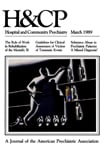Do Dangerousness-Oriented Commitment Laws Restrict Hospitalization of Patients Who Need Treatment? A Test
Abstract
A study at a large urban psychiatric hospital in Pennsylvania evaluated whether the state's dangerousness-oriented commitment criteria restricted bosp italization of patients whom emergency room clinicians considered highly in need of treatment but not dangerous. A total of 390 patients were studied. Eleven patients judged to be highly in need of treatment did not meet any of the commitment criteria, but they were largely compliant with the idea of being treated. An additional 17 patients considered highly in need of treatment met criteria for commitment based on inability to care for self, but most were hospitalized voluntarily. Only one patient who met none of the commitment criteria resisted recommended hospital care, and she was eventually committed involuntarily based on inability to care for self. The data suggest that dangerousness-oriented commitment criteria are flexible enough to provide for treatment of patients in serious need.
Access content
To read the fulltext, please use one of the options below to sign in or purchase access.- Personal login
- Institutional Login
- Sign in via OpenAthens
- Register for access
-
Please login/register if you wish to pair your device and check access availability.
Not a subscriber?
PsychiatryOnline subscription options offer access to the DSM-5 library, books, journals, CME, and patient resources. This all-in-one virtual library provides psychiatrists and mental health professionals with key resources for diagnosis, treatment, research, and professional development.
Need more help? PsychiatryOnline Customer Service may be reached by emailing [email protected] or by calling 800-368-5777 (in the U.S.) or 703-907-7322 (outside the U.S.).



